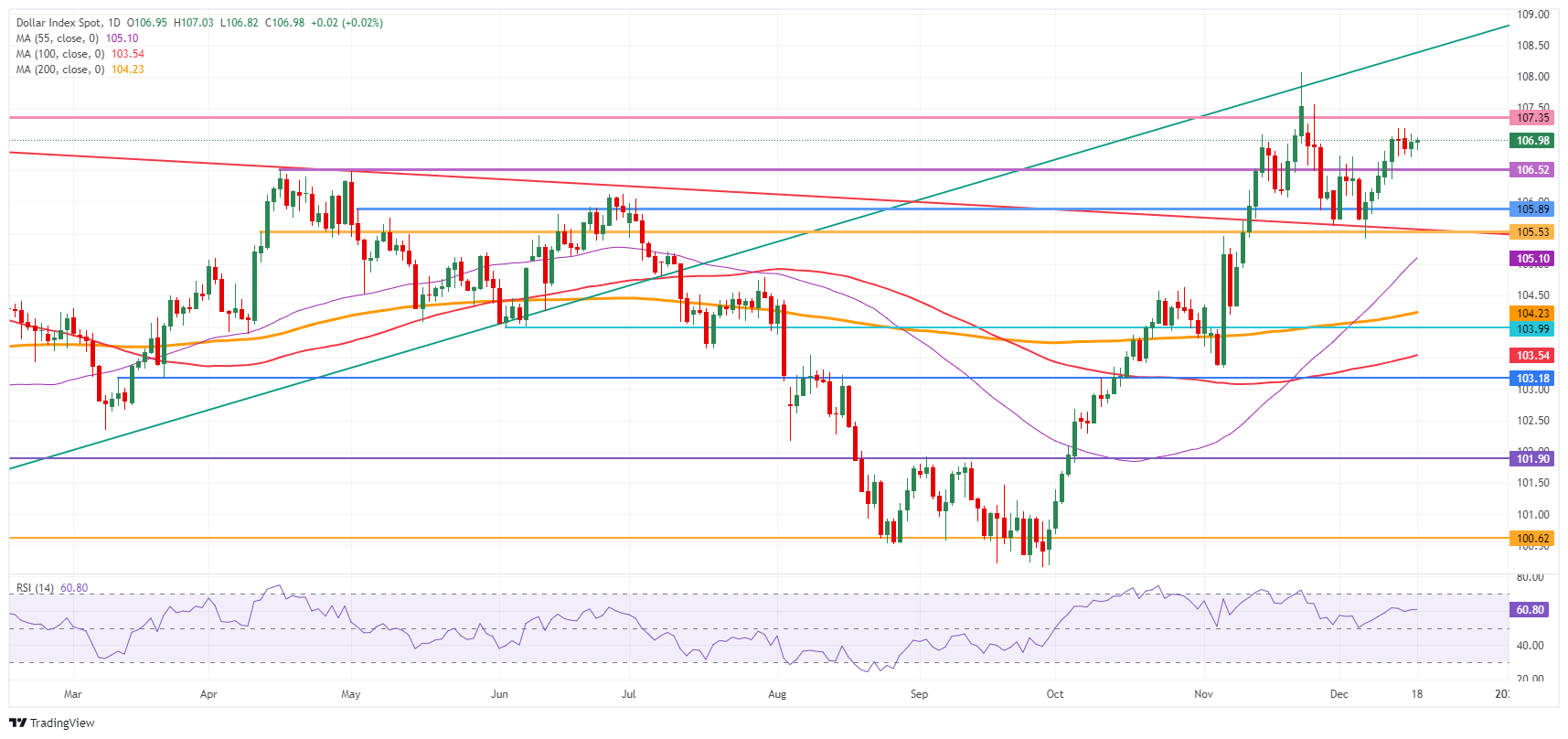US Dollar flattens ahead of last Fed meeting for 2024
- The US Dollar consolidates ahead of the Federal Reserve interest-rate decision.
- Traders will be looking at the dot plot for the number of rate cuts in 2025.
- The US Dollar Index (DXY) hovers around 107.00 and looks for direction.
The US Dollar (USD) consolidates on Wednesday, with the DXY Index hovering around 107.00, in the runup to the Federal Open Market Committee (FOMC) interest-rate decision. As markets widely expect a 25 basis points rate cut, the focus will be on Federal Reserve Chairman Jerome Powell’s comments and the publication of the dot plot, the projection of each individual FOMC member on where he or she sees rates in the medium and long term.
The US economic calendar in the run-up to the Fed meeting is rather light. Building Permits and Housing Starts data for November will be released. No big moves are expected from these numbers, although they could add to a specific conviction traders might have.
Daily digest market movers: Final event of 2024
- Near 13:30 GMT, the November Building Permits and Housing Starts will be published.
- Building Permits are expected to increase to 1.43 million from 1.419 million in October.
- Housing Starts should tick up to 1.34 million units from 1.311 million units in October.
- At 19:00 GMT, the Federal Reserve rate decision will be published. Expectations are for a 25 basis point rate cut to the 4.25%-4.50% range. At the same time, the Fed’s dot plot will be released as well.
- Near 19:30 GMT, Fed Chairman Jerome Powell will take the stage to deliver comments and have a Q&A on the recent rate decision from the Fed.
- Equities in Europe and Futures in the US are in the green, supported by the rate cut expectation.
- The CME FedWatch Tool is pricing in another 25 basis points (bps) rate cut by the Fed at Wednesday’s meeting by 95.4%.
- The US 10-year benchmark rate trades at 4.40%, in the middle of this week’s range.
US Dollar Index Technical Analysis: Last call for 2024
The US Dollar Index (DXY) is set for the last biggest market-moving event for 2024, unless a geopolitical outside risk takes place. The dot plot projections will be the most market moving event. In case Fed members are factoring in a Trump-effect for 2025, upward rate projections for 2025 and further would mean a stronger US Dollar, with the yield gap between the US and other countries widening even more right at the end of the year amid thinner liquidity conditions.
On the upside, 107.00 remains a key level that needs to be reclaimed with a firm daily close above it before considering 108.00. When and if that finally happens, the fresh two-year high at 108.07 from November 22 is the next level to watch for.
Looking down, 106.52 is the new first supportive level in case of profit-taking. Next in line is the pivotal level at 105.53 (the April 11 high), which comes into play before heading into the 104-region. Should the DXY fall towards 104.00, the 200-day Simple Moving Average at 104.19 should catch any falling knife formation.
US Dollar Index: Daily Chart
US Dollar FAQs
The US Dollar (USD) is the official currency of the United States of America, and the ‘de facto’ currency of a significant number of other countries where it is found in circulation alongside local notes. It is the most heavily traded currency in the world, accounting for over 88% of all global foreign exchange turnover, or an average of $6.6 trillion in transactions per day, according to data from 2022. Following the second world war, the USD took over from the British Pound as the world’s reserve currency. For most of its history, the US Dollar was backed by Gold, until the Bretton Woods Agreement in 1971 when the Gold Standard went away.
The most important single factor impacting on the value of the US Dollar is monetary policy, which is shaped by the Federal Reserve (Fed). The Fed has two mandates: to achieve price stability (control inflation) and foster full employment. Its primary tool to achieve these two goals is by adjusting interest rates. When prices are rising too quickly and inflation is above the Fed’s 2% target, the Fed will raise rates, which helps the USD value. When inflation falls below 2% or the Unemployment Rate is too high, the Fed may lower interest rates, which weighs on the Greenback.
In extreme situations, the Federal Reserve can also print more Dollars and enact quantitative easing (QE). QE is the process by which the Fed substantially increases the flow of credit in a stuck financial system. It is a non-standard policy measure used when credit has dried up because banks will not lend to each other (out of the fear of counterparty default). It is a last resort when simply lowering interest rates is unlikely to achieve the necessary result. It was the Fed’s weapon of choice to combat the credit crunch that occurred during the Great Financial Crisis in 2008. It involves the Fed printing more Dollars and using them to buy US government bonds predominantly from financial institutions. QE usually leads to a weaker US Dollar.
Quantitative tightening (QT) is the reverse process whereby the Federal Reserve stops buying bonds from financial institutions and does not reinvest the principal from the bonds it holds maturing in new purchases. It is usually positive for the US Dollar.



